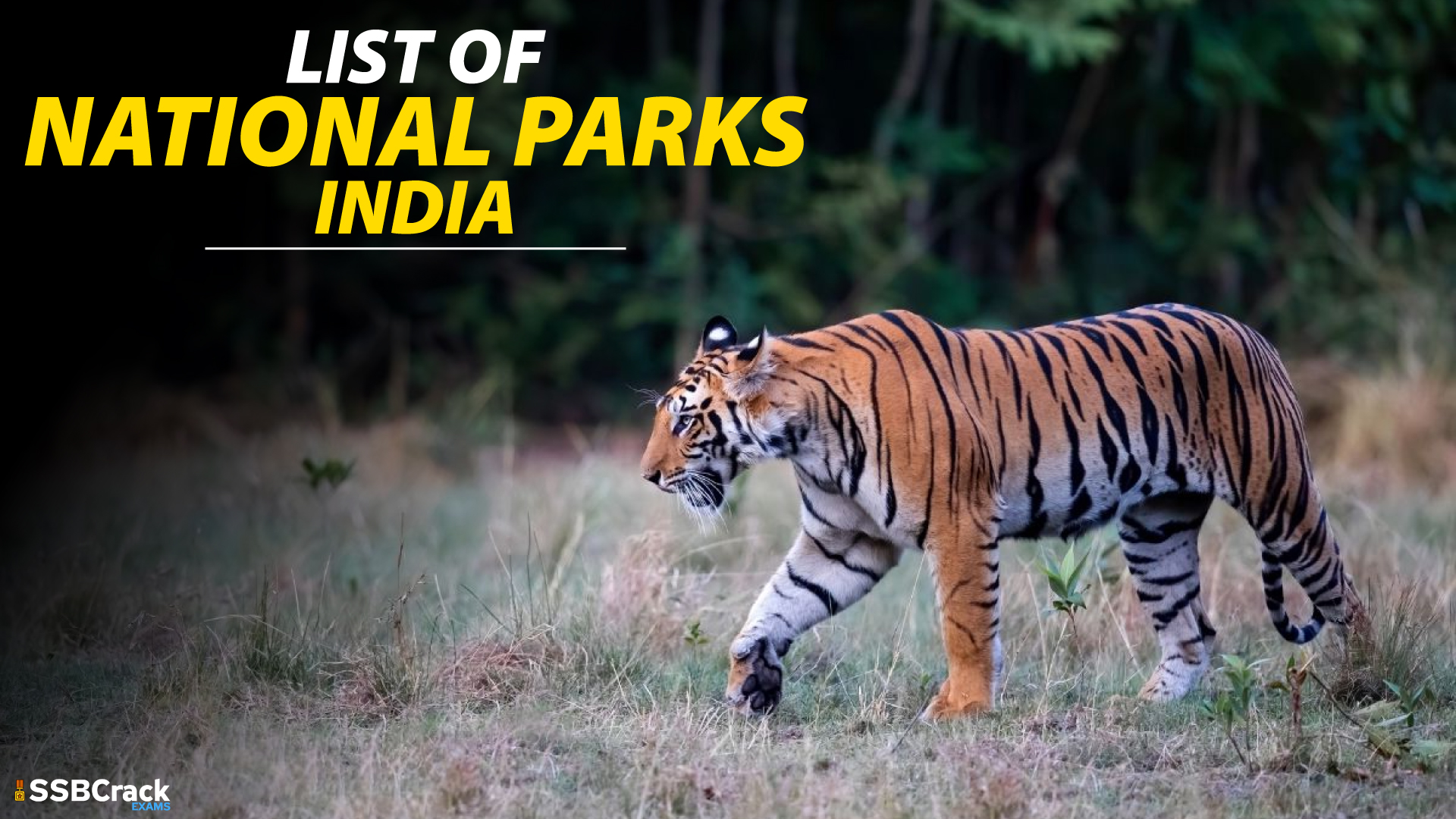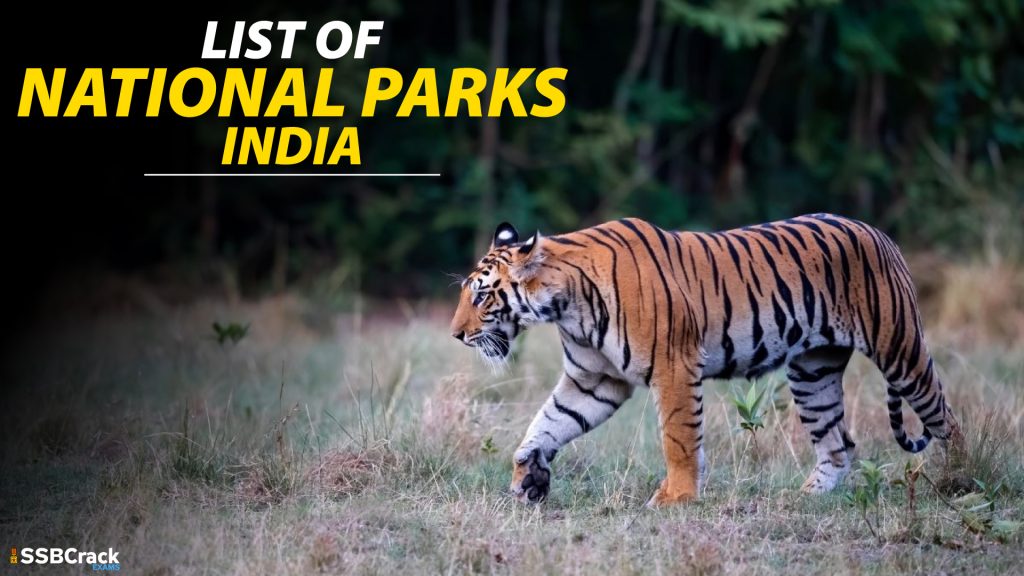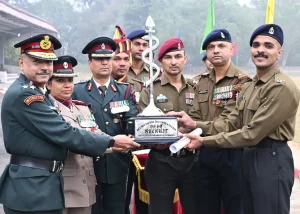It is important for defence aspirants to learn about wildlife conservation in India. Our national parks are an important feature of our wildlife conservation measures. In this article we present to you all you need to know about national parks.
What is a National Park?
A national park is a natural area set aside by the government of any state for environmental protection. A national park may be visited for recreational purposes or for its scientific or historical importance. National Parks are protected locations in India under Act 35(A) of the Wild Life Protection Act, 1972. When Jim Corbett National Park, Uttarakhand, was established in 1936, it became India’s first national park, initially known as Hailey National Park. The largest national park in India is Hemis National Park, Ladakh and the smallest one is South Button Island National Park, Andaman and Nicobar Islands.There are 106 national parks in India. We present you the list of national parks in India:
Significance of National Parks
1. Conservation of Nature
Our national parks are the backbone of India’s biodiversity conservation efforts, including critical habitat that allows animals and plants to live and grow. They form a ‘backbone’ of core conservation areas that may be linked by conservation activities across tenures, providing a diversified, healthy, and resilient ecosystem, when combined with additional protected areas. Saving endangered species, which are found in our national parks, requires a well-connected landscape. Furthermore, our protected areas provide life-sustaining services that are critical to the health of our ecosystem and society, such as the preservation of urban water catchments and climate improvement.
2. Economic advantages
National parks contribute significantly to India’s economy, with nature-based tourism bringing in billions each year. The millions of visitors who visit our national parks each year support regional communities by creating jobs and spending money on lodging, fuel, and food. Natural regions in good condition also supply a number of materials and processes that are essential to human existence and the economy. Protected areas, for example, provide a water collection and filter service, enhancing the quality of the water we drink, use for agriculture, and utilise in industry.
3. Cultural Impact
History and culture abound in national parks. Indigenous and tribal peoples continue to use our protected areas for a variety of purposes, including food, tools, medicine, and commerce, as well as ceremonial and spiritual activities. People may create and maintain relationships with
the land, as well as share their priceless cultural knowledge with the greater community, by visiting national parks.
4. Health and Well-Being
Natural environments have a significant impact on our physical and mental wellness. Our national parks are significant sanctuaries in our increasingly hectic world, where people may take time off to appreciate nature, get active, relax, and rejuvenate, while nature’s intrinsic beauty provides a source of artistic, creative, and spiritual inspiration. Contact with the natural environment has been shown to have a substantial positive psychological effect, reducing stress, anger, frustration, and aggressiveness, allowing for social bonding, and offering a location for learning and cerebral stimulation, according to research. Playing outside has long-term advantages for children in particular. Aside from the obvious health and wellness advantages, our national parks also support us in less visible ways, such as functioning as natural buffers against extreme weather occurrences, assisting in climate management, and supplying us with clean water and food.
Here is the state-wise list of National Parks in India.
| State/Union Territory | National Parks Name | Establishment Year |
| Andaman & Nicobar Islands | Campbell Bay National Park | 1992 |
| Andaman & Nicobar Islands | Galathea Bay National Park | 1992 |
| Andaman & Nicobar Islands | Mahatama Gandhi Marine (Wandoor) National Park | 1982 |
| Andaman & Nicobar Islands | Middle Button Island National Park | 1987 |
| Andaman & Nicobar Islands | Mount Harriett National Park | 1987 |
| Andaman & Nicobar Islands | North Button Island National Park | 1987 |
| Andaman & Nicobar Islands | Rani Jhansi Marine National Park | 1996 |
| Andaman & Nicobar Islands | Saddle Peak National Park | 1987 |
| Andaman & Nicobar Islands | South Button Island National Park | 1987 |
| Andhra Pradesh | Papikonda National Park | 2008 |
| Andhra Pradesh | Rajiv Gandhi (Rameswaram) National Park | 2005 |
| Andhra Pradesh | Sri Venkateswara National Park | 1989 |
| Arunachal Pradesh | Mouling National Park | 1986 |
| Arunachal Pradesh | Namdapha National Park | 1983 |
| Assam | Dibru-Saikhowa National Park | 1999 |
| Assam | Kaziranga National Park | 1974 |
| Assam | Manas National Park | 1990 |
| Assam | Nameri National Park | 1998 |
| Assam | Rajiv Gandhi Orang National Park | 1999 |
| Bihar | Valmiki National Park | 1989 |
| Chhattisgarh | Guru Ghasidas (Sanjay) National Park | 1981 |
| Chhattisgarh | Indravati (Kutru) National Park | 1982 |
| Chhattisgarh | Kanger Valley National Park | 1982 |
| Goa | Mollem National Park | 1992 |
| Gujarat | Vansda National Park | 1979 |
| Gujarat | Blackbuck (Velavadar) National Park | 1976 |
| Gujarat | Gir National Park | 1975 |
| Gujarat | Marine (Gulf of Kachchh) National Park | 1982 |
| Haryana | Kalesar National Park | 2003 |
| Haryana | SultaNational Parkur National Park | 1989 |
| Himachal Pradesh | Great Himalayan National Park | 1984 |
| Himachal Pradesh | Inderkilla National Park | 2010 |
| Himachal Pradesh | Khirganga National Park | 2010 |
| Himachal Pradesh | Pin Valley National Park | 1987 |
| Himachal Pradesh | Simbalbara National Park | 2010 |
| Jammu and Kashmir | City Forest (Salim Ali) National Park | 1992 |
| Jammu and Kashmir | Dachigam National Park | 1981 |
| Jammu and Kashmir | Kishtwar National Park | 1981 |
| Jharkhand | Betla National Park | 1986 |
| Karnataka | Anshi National Park | 1987 |
| Karnataka | Bandipur National Park | 1974 |
| Karnataka | Bannerghatta National Park | 1974 |
| Karnataka | Kudremukh National Park | 1987 |
| Karnataka | Nagarahole (Rajiv Gandhi) National Park | 1988 |
| Kerala | Anamudi Shola National Park | 2003 |
| Kerala | Eravikulam National Park | 1978 |
| Kerala | Mathikettan Shola National Park | 2003 |
| Kerala | Pambadum Shola National Park | 2003 |
| Kerala | Periyar National Park | 1982 |
| Kerala | Silent Valley National Park | 1984 |
| Madhya Pradesh | Bandhavgarh National Park | 1968 |
| Madhya Pradesh | Fossil National Park | 1983 |
| Madhya Pradesh | Indira Priyadarshini Pench National Park | 1975 |
| Madhya Pradesh | Kanha National Park | 1955 |
| Madhya Pradesh | Madhav National Park | 1959 |
| Madhya Pradesh | Panna National Park | 1981 |
| Madhya Pradesh | Sanjay National Park | 1981 |
| Madhya Pradesh | Satpura National Park | 1981 |
| Madhya Pradesh | Van Vihar National Park | 1979 |
| Maharashtra | Chandoli National Park | 2004 |
| Maharashtra | Gugamal National Park | 1975 |
| Maharashtra | Nawegaon National Park | 1975 |
| Maharashtra | Pench (Jawaharlal Nehru) National Park | 1975 |
| Maharashtra | Sanjay Gandhi (Borivali) National Park | 1983 |
| Maharashtra | Tadoba National Park | 1955 |
| Manipur | Keibul-Lamjao National Park | 1977 |
| Meghalaya | Balphakram National Park | 1985 |
| Meghalaya | Nokrek Ridge National Park | 1986 |
| Mizoram | Murlen National Park | 1991 |
| Mizoram | Phawngpui Blue Mountain National Park | 1992 |
| Nagaland | Intanki National Park | 1993 |
| Odisha | Bhitarkanika National Park | 1988 |
| Odisha | Simlipal National Park | 1980 |
| Rajasthan | Mukundra Hills National Park | 2006 |
| Rajasthan | Desert National Park | 1992 |
| Rajasthan | Keoladeo Ghana National Park | 1981 |
| Rajasthan | Ranthambhore National Park | 1980 |
| Rajasthan | Sariska National Park | 1992 |
| Sikkim | Khangchendzonga National Park | 1977 |
| Tamil Nadu | Guindy National Park | 1976 |
| Tamil Nadu | Gulf of Mannar Marine National Park | 1980 |
| Tamil Nadu | Indira Gandhi (Annamalai) National Park | 1989 |
| Tamil Nadu | Mudumalai National Park | 1990 |
| Tamil Nadu | Mukurthi National Park | 1990 |
| Ladakh | Hemis National Park | 1981 |
| Telangana | Kasu Brahmananda Reddy National Park | 1994 |
| Telangana | Mahaveer Harina Vanasthali National Park | 1994 |
| Telangana | Mrugavani National Park | 1994 |
| Tripura | Clouded Leopard National Park | 2007 |
| Tripura | Bison (Rajbari) National Park | 2007 |
| Uttar Pradesh | Dudhwa National Park | 1977 |
| Uttarakhand | Corbett National Park | 1936 |
| Uttarakhand | Gangotri National Park | 1989 |
| Uttarakhand | Govind National Park | 1990 |
| Uttarakhand | Nanda Devi National Park | 1982 |
| Uttarakhand | Rajaji National Park | 1983 |
| Uttarakhand | Valley of Flowers National Park | 1982 |
| West Bengal | Buxa National Park | 1992 |
| West Bengal | Gorumara National Park | 1992 |
| West Bengal | Jaldapara National Park | 2014 |
| West Bengal | Neora Valley National Park | 1986 |
| West Bengal | Singalila National Park | 1986 |
| West Bengal | Sunderban National Park | 1984 |
Conclusion
The value of national parks may be measured in a variety of ways. National parks are critical for preserving biodiversity by supporting ecosystems and the flora that live within them, protecting the environment by providing sustainable energy and mitigating the effects of climate change, and supporting national and local economies by promoting tourism and protecting agriculture.
The readers can subscribe to SSBCrackExams to get more informative articles in their feed. All the best.
Also Read:




















